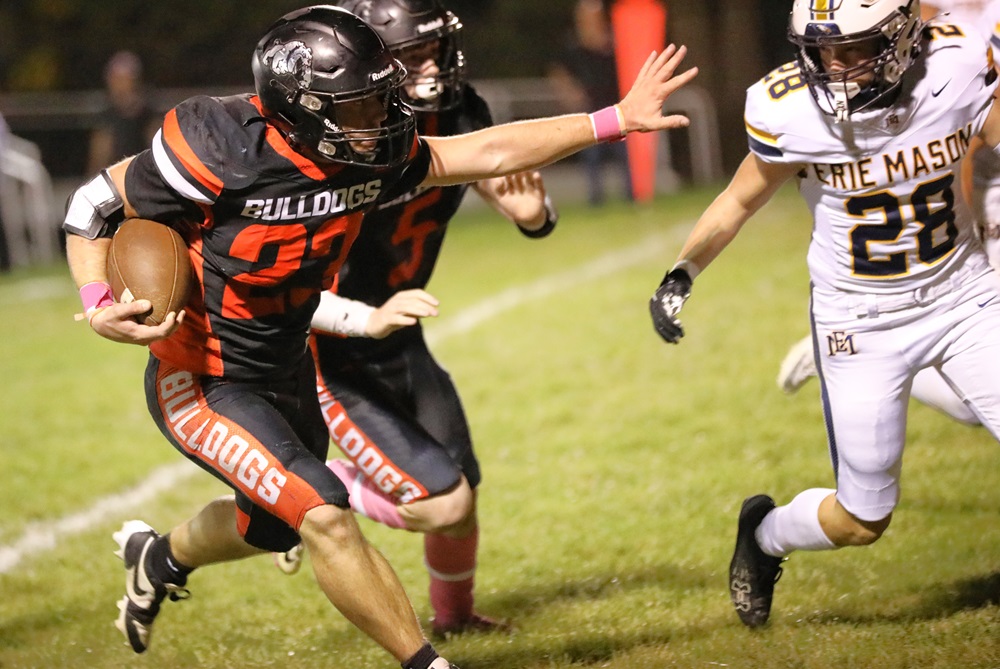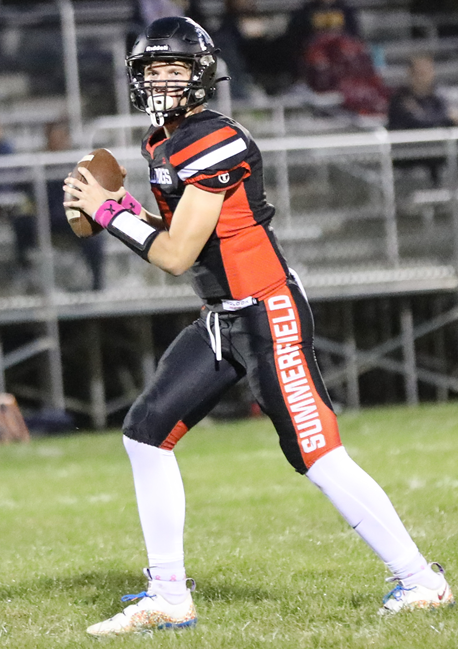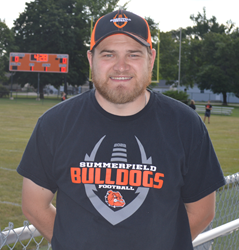
Inside Selection Sunday: Mapnalysis 2012
October 24, 2012
By Geoff Kimmerly
Second Half editor
Between double checking data for more than a third of our 626 football teams, and creating 136 first-round games for our most popular tournament, the morning of MHSAA football "Selection Sunday" is both one of the most exciting and nerve-wracking of the school year.
So for those scratching their heads the last few days over how we picked the brackets this season, I offer one question and one warning:
How would you have done so differently?
And before you answer, remember that moving the position of one school affects at least seven more – if not all 32 in that division.
This was the second year I was involved in the football selection process, which while appearing simple on its face actually is layered with hours of discussions, calculations, checking and re-checking, and anything else we at the MHSAA can do to make sure we’ve created the best tournament possible.
Simply put, it’s more than just drawing circles and calling them good.
Below are a brief description of what we do, the history behind the process, and some challenges we face each time we draw these brackets – including some examples of our toughest this time around.
The process
Our past: The MHSAA playoff structure – with 256 teams in eight divisions, and six wins equaling an automatic berth – debuted in 1999. An 8-player tournament was added in 2011, resulting in nine champions total when November is done.
That’s a long way from our start. The first playoffs were conducted in 1975 with four champions. Four more football classes were added in 1990 for a total of eight champions each fall. Through 1998, only 128 teams made the postseason, based on their playoff point averages within regions (four for each class) that were drawn before the beginning of the season. The drawing of Districts and Regions after the end of the regular season did not begin until the most recent playoff expansion.
In early years of the current process (or until the middle of the last decade), lines were drawn by hand. Dots representing qualifying schools were pasted on maps, one map for each division, and those maps were then covered by plastic sheets. Districts and Regionals literally were drawn with dry-erase markers.
Our present: After a late Saturday night tracking scores, we file in as the sun rises Sunday morning for a final round of gathering results we may still need (which can include making a few early a.m. calls to athletic directors). Then comes re-checking and triple-checking of enrollments, co-ops, some records and more before the numbers are crunched and the field of 256 is set.
Those teams are then split into eight equal divisions based on enrollment, and their locations are marked on digital maps that are projected on wall-size screens and then discussed by nearly half of the MHSAA staff plus a representative from the Michigan High School Football Coaches Association. Only the locations themselves are marked (by yellow dots) – not records, playoff points averages or names of the schools or towns. In fact, mentions of those are strictly prohibited. Records and playoff points are not part of the criteria. Matchups, rivalries, previous playoff pairings, etc. also DO NOT come into play.
Geography rules: Drawing Districts and Regionals is all about location. Travel distance and ease DO come into play. Yes, ease is important. Schools near the same major highway might be further from each other in mileage than other options but have a better trip. A good example this year is in Division 6, which has seven teams in the U.P. and the northern Lower Peninsula. That meant Shelby needed to be included with those teams to make eight, and left Montague to a District that includes Hemlock – more than halfway across the Lower Peninsula. But at least, in this case, much of that trip will be on one roadway, M-46.
There is certainly conversation about every possible option. The staff splits into two groups, each handling four divisions (plus one of the groups handles 8-player too), and then the entire committee comes together to view all nine maps. There wasn’t one division where the group as a whole said, “That looks great, what’s next?”
Observations and answers
A different ballgame: I was asked whatever happened to Districts, meaning teams opening with opponents nearby. Remember that with eight divisions and 32 teams in each, the difference between maximum and minimum enrollments for each division is smaller than it used to be with just four classes, and the probability of finding two schools in the same division next door to each other is lower. This is especially true for our smaller schools, and those pairings are more spread out. Division 7 provides an excellent example. Opponents Dansville and Ottawa Lake Whiteford are 84 miles apart. But in another option considered, Dansville would’ve played Gobles – and those two are separated by 114 miles.
Points still matter: And that means strength of schedule is a big factor. After Districts are drawn, playoff point average determines the home team for those two games and Regionals as well. There are five Districts in which the team with the best or second-best record did not get home games because those teams’ playoff point averages ranked third among the four teams in those brackets. A number of other Districts have 8-1 teams playing at other 8-1 teams. It’s true: there are times a school can’t help the opponents it plays, because of league affiliation perhaps, and they have no control over how an opponent does the rest of the season. But a Class B team playing in a league with Class D schools can’t expect to compare averages well against teams in their division who face similarly-sized opponents during the regular season.
No boating: This didn’t come up last season, but did twice Sunday. We had to decide if it was a better trip for teams in the thumb to go around Saginaw Bay to play northern opponents, or instead send teams a little bit south of the thumb but with a straight shots north. As the bird flies, the thumb teams were closer in some cases. But I’ve never heard of a team hopping into a boat to get to a playoff game.
The fifth wheels: The toughest lines to draw are around areas with five schools in the same division. Remember, Districts come in fours, and one dot affects the rest. The Grand Rapids area gave us tough calls because of five teams in Divisions 2 and 4. The same was true in the southwest corner in Division 7 and the southeast corner in Division 6. No matter how we circled it, one of those teams got stuck with a longer trip. This time, that group included Caledonia, Grand Rapids South Christian, Blissfield and Gobles.
It’s easy to say certain areas of these maps should’ve been drawn differently. But again, keep in mind a statewide view.
Some of our pairings could create gigantic matchups earlier in the playoffs than those teams might like. But again, who is to decide which teams are the best and which matchups most “gigantic” before they prove it on the field? At least three teams touted during this fall as potentially the best in the state this season didn’t even win their conference titles.
And as I said in this analysis last year, determining the playoff schedule is just one step in many. Nine MHSAA champions must survive until the end, regardless of which opponents they face along the way.
Their journeys begin Friday.

Sparked by Offense Switch, Summerfield Sets Record-Breaking Scoring Pace
By
Doug Donnelly
Special for MHSAA.com
October 29, 2024
Dylan Szegedi might only be in his second season as a head varsity football coach, but he knows when to pull the plug on an offensive scheme.
 A change from the veer to a version of the gun-T has been the catalyst behind Petersburg-Summerfield’s 8-1 season, the best at the Monroe County school in more than a decade.
A change from the veer to a version of the gun-T has been the catalyst behind Petersburg-Summerfield’s 8-1 season, the best at the Monroe County school in more than a decade.
“I really love the veer. I’ve seen it work very well,” Szegedi said. “It just didn’t work for us. We always say we were trying to put a round peg through a square hole. It just didn’t jell with our guys, and we were smart enough to realize it.”
The Bulldogs went 5-4 last season but missed the playoffs for the second straight. With several second- and third-year starting seniors back, Szegedi decided to change offenses despite having spent nearly all his years coaching the veer. He and his coaching staff started researching offenses and landed on one that is the mastermind of a coach in Alabama that puts a lot of YouTube videos together and travels around the country talking about his offensive concepts.
“This offense is perfect for our guys,” Szegedi said. “It’s a good mix of running and passing. It’s a good mix of spread but still some downhill-style run concepts. It fits our athletes to a T. It is a spread-T concept, wing-T running concepts with a spread flair to it. It was exactly what we needed.”
Heading into Friday’s home Division 8 playoff game against Manchester – the first hosted by Summerfield since 2015 – the Bulldogs are one point shy of the school record for points scored in a season. Since a 20-14 win over Ottawa Lake Whiteford in Week 5, Summerfield has scored 48, 62, 70 and 58 points in victories. The 70 points against Vanlue, Ohio, was a single-game school record.
 “It’s come together seamlessly. The proof is in the pudding. We have done great, and hopefully we will continue to do so,” Szegedi said.
“It’s come together seamlessly. The proof is in the pudding. We have done great, and hopefully we will continue to do so,” Szegedi said.
The new offense suits quarterback Trace Secor much better.
“I like this one,” Secor said. “It fits our style of play and the players we have. It complements us.”
Secor has passed for 1,248 yards and 21 touchdowns.
Senior receiver Tyler Dafoe has 743 yards and 12 touchdowns receiving. Bruising tight end Brenden Myshock has six touchdown receptions, and big-play Eli VanHuysen has caught 18 passes for 391 yards and another six touchdowns.
Senior running back Mitchell Gomulinski has had a tremendous season as well. Through nine games, he has rushed for 1,398 yards, averaging more than nine per carry. He has scored 17 touchdowns.
“Mitchell is he is our emotional leader,” Szegedi said. “He keeps everybody going and is the guy the other people look for to set the example. He’s worked very hard. I’m just proud of what he was able to do.”
The Summerfield defense has been rock-solid too. Since halftime of the Whiteford game, the Bulldogs have allowed just two touchdowns over 18 quarters. Gomulinski has 80 tackles. Dafoe and Gabe Ostrosky have five interceptions apiece.
The biggest win came against Whiteford, which played in MHSAA Finals in 2022 and 2023. It propelled the Bulldogs to the Tri-County Conference championship.
“When we beat Whiteford, that really changed the attitude of a lot of our guys,” Szegedi said. “Not that they didn’t believe before, but after that victory, I think we just started believing even more. It gave them affirmation that if we could beat them, we could hang with anybody. It gave them the belief that, ‘Hey, maybe we are pretty good.’”
The community has rallied behind the team. At a watch party Sunday when the MHSAA released the playoff pairings, about 150 parents, students and other community members met in the high school cafeteria.
 “There is talk about how they are going to decorate the town and decorate the stadium,” Szegedi said. “Last Friday the stadium was packed. That’s the way it should be.”
“There is talk about how they are going to decorate the town and decorate the stadium,” Szegedi said. “Last Friday the stadium was packed. That’s the way it should be.”
The Oregon, Ohio, native graduated from Toledo St. Francis in 2011 where he played football and was on the Knights swim team. He then continued at Wayne State University and was a two-time Division II national champion diver, earning All-America honors eight times. He was the Great Lakes Intercollegiate Athletic Conference Diver of the Year multiple times and was inducted into the Wayne State Athletic Hall of Fame.
After college he came home and decided he wanted to get into coaching football. He called his former freshman coach at St. Francis, Geoff Skibinski, and joined the coaching staff.
Since then, he and Skibinski have coached at multiple stops together. When Szegedi was hired at Summerfield in 2023, his first call was to Skibinski, who runs the Summerfield offense.
“He and I work well together,” Szegedi said. “We have a good trust in one another.”
Summerfield’s 8-1 record is the best for the school since 2010, which was also the last time the Bulldogs won a conference championship.
Szegedi is glad to see the success the 11 seniors are enjoying.
“These are guys who have played a ton of varsity football,” he said. “It’s fun to see all of the time they spent in the summer running and all of the extra lifting pay off. They are guys who deserve it. They’ve worked very hard and deserve the success they are now experiencing.”
 Doug Donnelly has served as a sports and news reporter and city editor over 25 years, writing for the Daily Chief-Union in Upper Sandusky, Ohio from 1992-1995, the Monroe Evening News from 1995-2012 and the Adrian Daily Telegram since 2013. He's also written a book on high school basketball in Monroe County and compiles record books for various schools in southeast Michigan. E-mail him at [email protected] with story ideas for Jackson, Washtenaw, Hillsdale, Lenawee and Monroe counties.
Doug Donnelly has served as a sports and news reporter and city editor over 25 years, writing for the Daily Chief-Union in Upper Sandusky, Ohio from 1992-1995, the Monroe Evening News from 1995-2012 and the Adrian Daily Telegram since 2013. He's also written a book on high school basketball in Monroe County and compiles record books for various schools in southeast Michigan. E-mail him at [email protected] with story ideas for Jackson, Washtenaw, Hillsdale, Lenawee and Monroe counties.
PHOTOS (Top) Petersburg Summerfield’s Mitchell Gomulinski (23) prepares to take on a defender from Erie Mason this season. (Middle) Bulldogs quarterback Trace Secor considers his options from the pocket. (Below) Summerfield coach Dylan Szegedi. (Action photos by Kendra Dafoe; Szegedi photo by Doug Donnelly.)

